Capital Asset Pricing Model for IBM Stocks
Analysis of IBM’s 1994-2015 stock market performance using Capital Asset Pricing Model (CAPM).
Step 1: Imported the data into RStudio environment
The data contains:
- Dates (Jan 1994 - Dec 2015)
- IBM’s daily return
- Market’s daily return
- Daily risk-free rate
Step 2: Computed yearly excess market and IBM stock returns
lg <- length(ibmRET)
IBMEXRET_Annualized <- rep(NA,lg)
marketEXRET_Annualized <- rep(NA,lg)
for (i in 252:lg){
IBMEXRET_Annualized[i] <- (prod(IBMEXRET[(i-252+1):(i)]/100+1)-1)*100 # Daily excess IBM returns
marketEXRET_Annualized[i] <- (prod(marketEXRET[(i-252+1):(i)]/100+1)-1)*100 # Daily excess Market Returns
}
Time-series plot of market’s annual excess return:
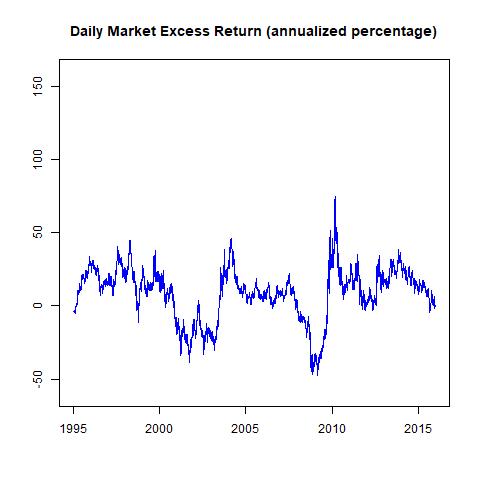
Step 3: Found the global maximum
On 3rd September 2010, the market was at the global maximum (75.06%).
Step 4: Computed 5-yearly excess market and IBM stock returns
IBMEXRET_5Year <- rep(NA,lg)
marketEXRET_5Year <- rep(NA,lg)
for(i in (252*5):lg){
IBMEXRET_5Year[i] <- (prod(IBMEXRET[(i-252*5+1):(i)]/100+1)^(1/5)-1)*100 # Five-year IBM excess returns
marketEXRET_5Year[i] <- (prod(marketEXRET[(i-252*5+1):(i)]/100+1)^(1/5)-1)*100 # Five-year Market excess returns
}
Time-series plot of market’s 5-yearly excess return:
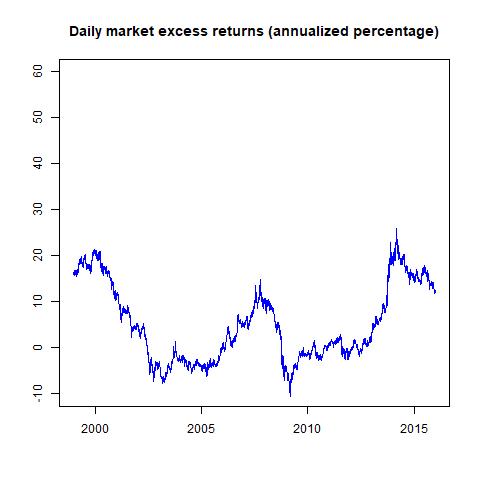
Step 5: Visualize the spread of the daily returns
- Boxplot of excess market returns:
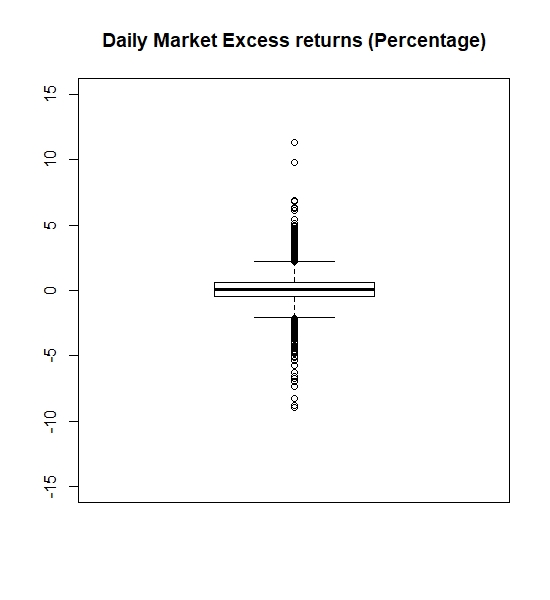
- Boxplot of excess IBM’s stock returns:

- Scatter-plot of daily IBM vs. market excess returns:
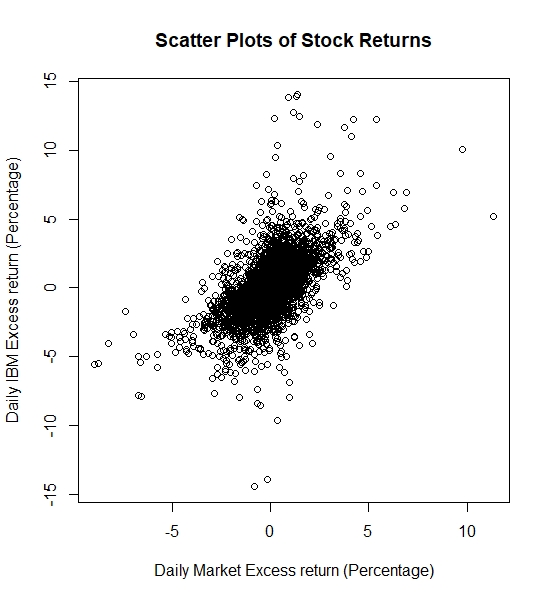
Step 6: Check the various moments of IBM’s and market excess returns:
| Metric | IBM’s daily stock return | Market’s daily stock return |
|---|---|---|
| Mean | 17.38198% | 7.892513% |
| Standard deviation | 28.8362% | 18.83606% |
| Skewness | 0.580013 | -0.1168607 |
| Kurtosis | 8.060213 | 7.639527 |
| Minimum | -14.41947% | -8.95% |
| Maximum | 14.05134% | 11.35% |
| Sharpe ratio | 0.6028 | 0.4190 |
| Value at Risk | -2.6330% | -1.8305% |
| Expected Shortfall | -3.9803 | -2.8095 |
| Correlation | 0.5956 | NA |
Histogram of market’s excess returns:
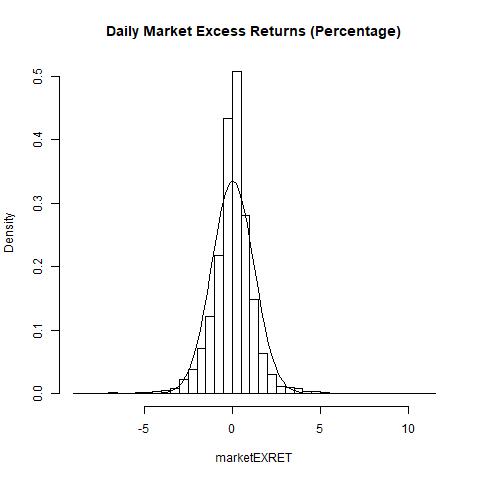
Histogram of IBM’s excess returns:

QQ-plot for market’s excess returns:
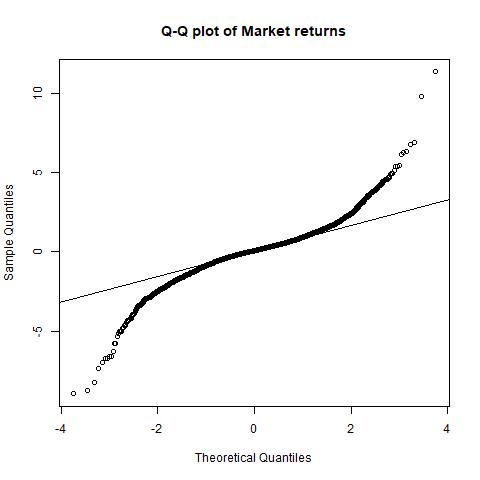
QQ-plot for IBM’s excess returns:
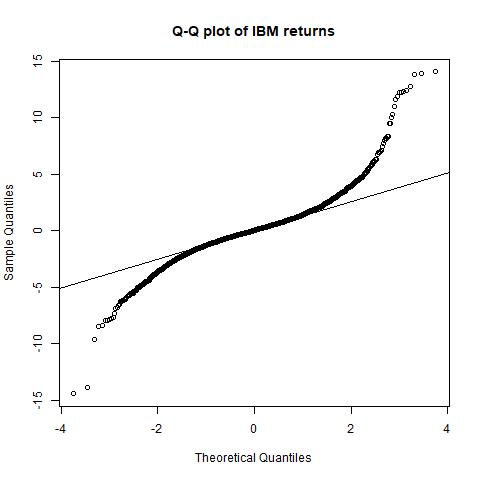
Step 7: Hypothesis testing
- The Jarque-Bera Test:
- For IBM: X-squared = 15322, degrees of freedom = 2, p-value < 2.2e-16
- For market: X-squared = 13498, degrees of freedom = 2, p-value < 2.2e-16
- The Lilliefors Test:
- For IBM: D = 0.081205, p-value < 2.2e-16
- For market: D = 0.084228, p-value < 2.2e-16
Step 8: Linear model estimation
We try to explain the behavior of IBM’s returns through market’s returns.
Results:
- Residuals:
| Min | 1Q | Median | 3Q | Max |
|---|---|---|---|---|
| -13.8015 | -0.6594 | -0.0582 | 0.5996 | 12.9184 |
- Coefficients:
| Coefficient | Estimate | Std. Error | t value | Pr > t |
|---|---|---|---|---|
| (Intercept) | 0.04042 | 0.01961 | 2.061 | 0.0394 |
| marketEXRET | 0.91177 | 0.01653 | 55.175 | <2e-16 |
Residual standard error: 1.459 on 5538 degrees of freedom
Multiple R-squared: 0.3547, Adjusted R-squared: 0.3546
F-statistic: 3044 on 1 and 5538 DF, p-value: < 2.2e-16
Plot of OLS line:

Alternate hypothesis: Is the risk adjusted returns zero? Result: Cannot reject null hypothesis, so risk-adjusted returns are not zero!
Note:
-
Sharpe ratio:
-
Value at Risk (VaR):
-
Expected Shortfall:
, where
is the confidence level
